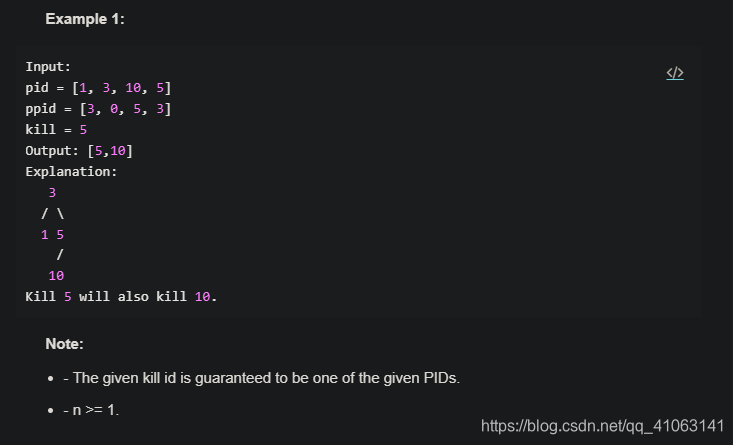本文主要是介绍内修算法之队列,希望对大家解决编程问题提供一定的参考价值,需要的开发者们随着小编来一起学习吧!
杀死进程
给你n个进程,每个进程都有一个唯一的PID(process id)和PPID(parent process id)。每个进程最多只有一个父进程,但可能有多个子进程。如果一个进程的PPID为0,表示它没有父进程。如果一个进程被杀死,那么它的子进程也会被杀死。输入两个相同长度的整数链表,第一个链表是每个进程的PID,第二个链表是对应位置进程的PPID,再输入一个将被杀死的进程的PID,请输出所有将被杀死的进程的PID。
例如,输入的PID链表为[1, 3, 10, 5],PPID链表为[3, 0, 5, 3],将被杀死的进程的PID为5,那么最终被杀死的进程有两个,PID分别为5和10。这是因为PID为10的进程是PID为5的进程的子进程。

public class App {public static void main(String args[]){int pidIn[]={1,2,3,4};int ppidIn[]={0,1,1,3};List<Integer>pid = Arrays.stream(pidIn).boxed().collect(Collectors.toList());List<Integer>ppid = Arrays.stream(ppidIn).boxed().collect(Collectors.toList());//Arrays.asList(items).forEach(item -> System.out.println(item));Arrays.asList(new App().killProcess(pid,ppid,3)).forEach(System.out::println);}/*** 用邻接表来表示一棵树,我们可以把整棵树存到一个HashMap中。* 这个HashMap的Key为进程的PID,Value为对应进程的所有子进程的PID,* 也就是树中对应节点的所有子节点。下面是根据PID和PPID链表构建树的参考代码:* ---------------- Iterator ------------------* 他是collection中的一个方法,可遍历数组/链表,用的是工厂模式* 通常使用Iterator的hasNext()方法结合while()来使用*/private Map<Integer, List<Integer>> buildTree(List<Integer> pid, List<Integer> ppid) {Map<Integer, List<Integer>> processTree = new HashMap<>();Iterator<Integer> iterator1 = pid.iterator();Iterator<Integer> iterator2 = ppid.iterator();while (iterator1.hasNext() && iterator2.hasNext()) {int p = iterator1.next();int pp = iterator2.next();if (!processTree.containsKey(pp)) {//避免重复操作processTree.put(pp, new LinkedList<>());}processTree.get(pp).add(p);}return processTree;}/*** 基于广度优先的代码通常会用到队列(queue)。我们首先把第一个待杀死的进程的PID放入队列中,* 接下来只要队列中还有待杀死的进程,就重复执行如下步骤:首先从队列中去除一个进程,杀死它(即添加到输出的链表中);* 接着,如果该进程有子进程则把子进程添加到队列中。* @param pid* @param ppid* @param target* @return*/public List<Integer> killProcess(List<Integer> pid, List<Integer> ppid, int target) {Map<Integer, List<Integer>> processTree = buildTree(pid, ppid);List<Integer> result = new LinkedList<>();Queue<Integer> queue = new LinkedList<>();queue.add(target);while (!queue.isEmpty()) {int process = queue.remove();result.add(process);if (processTree.containsKey(process)) {for (int child : processTree.get(process)) {queue.add(child);}}}return result;}
}
任务调度器
给定一个用字符数组表示的 CPU 需要执行的任务列表。其中包含使用大写的 A - Z 字母表示的26 种不同种类的任务。任务可以以任意顺序执行,并且每个任务都可以在 1 个单位时间内执行完。CPU 在任何一个单位时间内都可以执行一个任务,或者在待命状态。
然而,两个相同种类的任务之间必须有长度为 n 的冷却时间,因此至少有连续 n 个单位时间内 CPU 在执行不同的任务,或者在待命状态。
你需要计算完成所有任务所需要的最短时间。
示例 1:
输入: tasks = ["A","A","A","B","B","B"], n = 2
输出: 8
执行顺序: A -> B -> (待命) -> A -> B -> (待命) -> A -> B.
注:
任务的总个数为 [1, 10000]。
n 的取值范围为 [0, 100]
参考:
杀死进程代码实现+详细分析
https://www.cnblogs.com/yoke/p/9770528.html
任务调度器:
https://blog.csdn.net/qq_38595487/article/details/79977315
这篇关于内修算法之队列的文章就介绍到这儿,希望我们推荐的文章对编程师们有所帮助!







